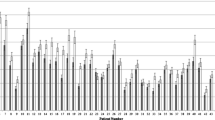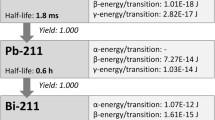Abstract
Objectives
To investigate whether physical exposure parameters such as the dose index (CTDI), dose length product (DLP), and size-specific dose estimate (SSDE) are predictive of DNA damage.
Methods
In vitro, we scanned a phantom containing blood samples from five volunteers at CTDI 50, 100, and 150 mGy. One sample was not scanned. We also scanned samples in three different-size phantoms at CTDI 100 mGy. In vivo, we enrolled 45 patients and obtained blood samples before and after cardiac CT. The γ-H2AX foci were counted.
Results
In vitro, in the control and at CTDI 50, 100, and 150 mGy, the number of γ-H2AX was 0.94 ± 0.24 (standard error, SE), 1.28 ± 0.30, 1.91 ± 0.47, and 2.16 ± 0.20. At SSDE 180, 156, and 135 mGy, it was 2.41 ± 0.20, 1.91 ± 0.47, and 1.42 ± 0.20 foci/cell. The γ-H2AX foci were positively correlated with the radiation dose and negatively correlated with the body size. In vivo, the γ-H2AX foci were significantly increased after CT (from 1.21 ± 0.19 to 1.92 ± 0.22 foci/cell) and correlated with CTDI, DLP, and SSDE.
Conclusions
DNA damage was induced by cardiac CT. There was a correlation between the physical exposure parameters and γ-H2AX.
Key Points
• DNA damage was induced by radiation exposure from cardiac CT.
• The γ-H2AX foci number was correlated with the CT radiation dose.
• Physical exposure parameters reflect the DNA damage by CT radiation exposure.





Similar content being viewed by others
Abbreviations
- CTDI:
-
CT dose index
- DLP:
-
Dose length product
- SSDE:
-
Size-specific dose estimates
References
Brenner DJ, Elliston CD (2004) Estimated radiation risks potentially associated with full-body CT screening. Radiology 232:735–738
Brix G, Lechel U, Nekolla E, Griebel J, Becker C (2014) Radiation protection issues in dynamic contrast-enhanced (perfusion) computed tomography. Eur J Radiol. doi:10.1016/j.ejrad.2014.11.011
Hochberg AR, Young GS (2012) Cerebral perfusion imaging. Semin Neurol 32:454–465
Raff GL, Gallagher MJ, O'Neill WW, Goldstein JA (2005) Diagnostic accuracy of noninvasive coronary angiography using 64-slice spiral computed tomography. J Am Coll Cardiol 46:552–557
Brenner DJ, Hall EJ (2007) Computed tomography−an increasing source of radiation exposure. N Engl J Med 357:2277–2284
Berrington de Gonzalez A, Darby S (2004) Risk of cancer from diagnostic X-rays: estimates for the UK and 14 other countries. Lancet 363:345–351
Rothkamm K, Balroop S, Shekhdar J, Fernie P, Goh V (2007) Leukocyte DNA damage after multi-detector row CT: a quantitative biomarker of low-level radiation exposure. Radiology 242:244–251
Salibi PN, Agarwal V, Panczykowski DM, Puccio AM, Sheetz MA, Okonkwo DO (2014) Lifetime attributable risk of cancer from CT among patients surviving severe traumatic brain injury. AJR Am J Roentgenol 202:397–400
Shah KH, Slovis BH, Runde D, Godbout B, Newman DH, Lee J (2013) Radiation exposure among patients with the highest CT scan utilization in the emergency department. Emerg Radiol 20:485–491
Wen JC, Sai V, Straatsma BR, McCannel TA (2013) Radiation-related cancer risk associated with radiographic imaging−reply. JAMA Ophthalmol 131:1249
Sodickson A, Baeyens PF, Andriole KP et al (2009) Recurrent CT, cumulative radiation exposure, and associated radiation-induced cancer risks from CT of adults. Radiology 251:175–184
McCollough CH, Leng S, Yu L, Cody DD, Boone JM, McNitt-Gray MF (2011) CT dose index and patient dose: they are not the same thing. Radiology 259:311–316
Brady SL, Kaufman RA (2012) Investigation of American Association of Physicists in Medicine Report 204 size-specific dose estimates for pediatric CT implementation. Radiology 265:832–840
Christner JA, Braun NN, Jacobsen MC, Carter RE, Kofler JM, McCollough CH (2012) Size-specific dose estimates for adult patients at CT of the torso. Radiology 265:841–847
Rogakou EP, Boon C, Redon C, Bonner WM (1999) Megabase chromatin domains involved in DNA double-strand breaks in vivo. J Cell Biol 146:905–916
Rogakou EP, Pilch DR, Orr AH, Ivanova VS, Bonner WM (1998) DNA double-stranded breaks induce histone H2AX phosphorylation on serine 139. J Biol Chem 273:5858–5868
Jackson SP (2002) Sensing and repairing DNA double-strand breaks. Carcinogenesis 23:687–696
Ishida M, Ishida T, Tashiro S et al (2014) Smoking cessation reverses DNA double-strand breaks in human mononuclear cells. PLoS One 9, e103993
Li B, Behrman RH (2012) Comment on the “report of AAPM TG 204: size-specific dose estimates (SSDE) in pediatric and adult body CT examinations” [report of AAPM TG 204, 2011]. Med Phys 39:4613–4614, author reply 4615-4616
Piechowiak EI, Peter JF, Kleb B, Klose KJ, Heverhagen JT (2015) Intravenous iodinated contrast agents amplify DNA radiation damage at CT. Radiology 275:692–697
Pathe C, Eble K, Schmitz-Beuting D et al (2011) The presence of iodinated contrast agents amplifies DNA radiation damage in computed tomography. Contrast Media Mol Imaging 6:507–513
Angele S, Romestaing P, Moullan N et al (2003) ATM haplotypes and cellular response to DNA damage: association with breast cancer risk and clinical radiosensitivity. Cancer Res 63:8717–8725
Zhang L, Yang M, Bi N et al (2010) Association of TGF-beta1 and XPD polymorphisms with severe acute radiation-induced esophageal toxicity in locally advanced lung cancer patients treated with radiotherapy. Radiother Oncol 97:19–25
Ismail IH, Wadhra TI, Hammarsten O (2007) An optimized method for detecting gamma-H2AX in blood cells reveals a significant interindividual variation in the gamma-H2AX response among humans. Nucleic Acids Res 35, e36
Andrievski A, Wilkins RC (2009) The response of gamma-H2AX in human lymphocytes and lymphocytes subsets measured in whole blood cultures. Int J Radiat Biol 85:369–376
Shrivastav M, De Haro LP, Nickoloff JA (2008) Regulation of DNA double-strand break repair pathway choice. Cell Res 18:134–147
Brenner DJ, Doll R, Goodhead DT et al (2003) Cancer risks attributable to low doses of ionizing radiation: assessing what we really know. Proc Natl Acad Sci U S A 100:13761–13766
Halm BM, Franke AA, Lai JF et al (2014) gamma-H2AX foci are increased in lymphocytes in vivo in young children 1 h after very low-dose X-irradiation: a pilot study. Pediatr Radiol 44:1310–1317
Lobrich M, Rief N, Kuhne M et al (2005) In vivo formation and repair of DNA double-strand breaks after computed tomography examinations. Proc Natl Acad Sci U S A 102:8984–8989
Beels L, Bacher K, Smeets P, Verstraete K, Vral A, Thierens H (2012) Dose-length product of scanners correlates with DNA damage in patients undergoing contrast CT. Eur J Radiol 81:1495–1499
Brand M, Sommer M, Achenbach S et al (2012) X-ray induced DNA double-strand breaks in coronary CT angiography: comparison of sequential, low-pitch helical and high-pitch helical data acquisition. Eur J Radiol 81:e357–e362
Vandevoorde C, Franck C, Bacher K et al (2015) Gamma-H2AX foci as in vivo effect biomarker in children emphasize the importance to minimize x-ray doses in paediatric CT imaging. Eur Radiol 25:800–811
Gould R, McFadden SL, Horn S, Prise KM, Doyle P, Hughes CM (2016) Assessment of DNA double-strand breaks induced by intravascular iodinated contrast media following in vitro irradiation and in vivo, during paediatric cardiac catheterization. Contrast Media Mol Imaging 11:122–129
Geisel D, Zimmermann E, Rief M et al (2012) DNA double-strand breaks as potential indicators for the biological effects of ionising radiation exposure from cardiac CT and conventional coronary angiography: a randomised, controlled study. Eur Radiol 22:1641–1650
Beels L, Bacher K, De Wolf D, Werbrouck J, Thierens H (2009) gamma-H2AX foci as a biomarker for patient X-ray exposure in pediatric cardiac catheterization: are we underestimating radiation risks? Circulation 120:1903–1909
Kato S, Yoshimura K, Kimata T, Mine K, Uchiyama T, Kaneko K (2015) Urinary 8-hydroxy-2'-deoxyguanosine: a biomarker for radiation-induced oxidative DNA Damage in pediatric cardiac catheterization. J Pediatr 167(1369-1374), e1361
Kubo T, Ohno Y, Kauczor HU, Hatabu H (2014) Radiation dose reduction in chest CT--review of available options. Eur J Radiol 83:1953–1961
Lee SW, Kim Y, Shim SS et al (2014) Image quality assessment of ultra low-dose chest CT using sinogram-affirmed iterative reconstruction. Eur Radiol 24:817–826
Gabusi M, Riccardi L, Aliberti C, Vio S, Paiusco M (2016) Radiation dose in chest CT: assessment of size-specific dose estimates based on water-equivalent correction. Phys Med 32:393–397
Acknowledgments
The scientific guarantor of this publication is Kazuo Awai, MD, PhD. The authors of this manuscript declare no relationships with any companies, whose products or services may be related to the subject matter of the article. This study has received funding by JSPS KAKENHI grant no. 25461825. One of the authors has significant statistical expertise. Institutional Review Board approval was obtained. Written informed consent was obtained from all subjects (patients) in this study. Methodology: prospective/prospective, experimental, performed at one institution.
Author information
Authors and Affiliations
Corresponding author
Rights and permissions
About this article
Cite this article
Fukumoto, W., Ishida, M., Sakai, C. et al. DNA damage in lymphocytes induced by cardiac CT and comparison with physical exposure parameters. Eur Radiol 27, 1660–1666 (2017). https://doi.org/10.1007/s00330-016-4519-8
Received:
Revised:
Accepted:
Published:
Issue Date:
DOI: https://doi.org/10.1007/s00330-016-4519-8




